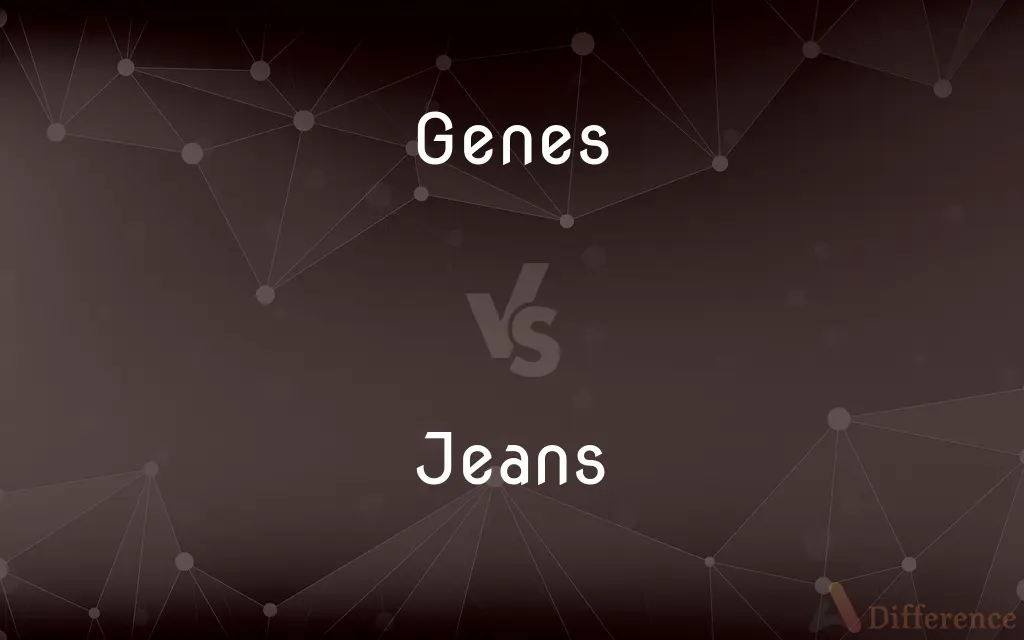Genes vs. Jeans — What's the Difference?
By Tayyaba Rehman & Maham Liaqat — Updated on April 26, 2024
Genes are fundamental units of heredity in living organisms, while jeans are a type of durable pants made from denim fabric.

Difference Between Genes and Jeans
Table of Contents
ADVERTISEMENT
Key Differences
Genes are sequences of DNA that contain the instructions for building proteins in biological organisms, crucial for defining traits and functions. On the other hand, jeans refer to a style of pants, typically made from denim, that are popular worldwide for their durability and fashion.
While genes are microscopic and not visible to the naked eye, jeans are tangible and regularly used in everyday fashion. This reflects the distinct nature of their forms and functions: biological information versus a physical garment.
In terms of variation, genes exist in different forms called alleles, which contribute to the genetic diversity seen within and among species. Whereas, jeans come in various styles, colors, and cuts, reflecting cultural and personal fashion preferences rather than biological diversity.
The study and manipulation of genes are central to fields like genetics, biotechnology, and medicine, aiming to understand and cure genetic diseases. Conversely, the manufacturing and styling of jeans are important in the fashion industry, impacting trends and economic markets.
Preservation methods for genes include cold storage of DNA samples and genetic databases, critical for research and maintaining biodiversity. Jeans, however, are preserved through proper care, washing, and sometimes fashion recycling or upcycling efforts.
ADVERTISEMENT
Comparison Chart
Definition
Units of heredity in living organisms.
Durable trousers made from denim.
Purpose
Determine biological traits.
Fashion and utility wear.
Material
DNA sequences.
Denim fabric.
Variation
Different alleles.
Styles, colors, cuts.
Field of Relevance
Genetics, biotechnology.
Fashion, textile industry.
Compare with Definitions
Genes
Hereditary units within DNA.
Scientists study genes to understand genetic disorders.
Jeans
Can be styled in numerous ways.
Ripped jeans are popular among teenagers.
Genes
Basis for traits in organisms.
Genes determine everything from hair color to disease susceptibility.
Jeans
Durable and meant for casual wear.
Jeans are perfect for outdoor activities.
Genes
Can mutate and change.
Gene mutations can lead to evolution or diseases.
Jeans
Often blue but available in various colors.
He prefers black jeans over blue.
Genes
Replicated during cell division.
During cell division, genes are copied to new cells.
Jeans
Fashion staple in modern wardrobes.
Jeans remain a constant in changing fashion trends.
Genes
Targeted in genetic engineering.
Genetic engineers modify genes to create disease-resistant crops.
Jeans
Pants made from denim.
She bought a new pair of jeans for the concert.
Genes
A hereditary unit consisting of a sequence of DNA that occupies a specific location on a chromosome and is transcribed into an RNA molecule that may function directly or be translated into an amino acid chain. Genes undergo mutation when their DNA sequences change.
Jeans
Jeans are a type of pants or trousers, typically made from denim or dungaree cloth. Often the term "jeans" refers to a particular style of trousers, called "blue jeans", which were invented by Jacob W. Davis in partnership with Levi Strauss & Co.
Genes
Plural of gene
Jeans
Hard-wearing casual trousers made of denim or other cotton fabric
He wore a pair of faded jeans and a white T-shirt
Jeans
A strong, twilled cotton, traditionally used in making uniforms and work clothes.
Jeans
Jeans Pants made of jean, denim, or another durable fabric.
Jeans
A pair of trousers made from denim cotton.
Traditionally most jeans are dyed dark blue.
Jeans
Plural of jean
Common Curiosities
How should jeans be cared for?
Jeans should be washed sparingly and with care to maintain their color and durability.
What are jeans?
Jeans are sturdy trousers made from denim fabric, typically blue but available in various colors.
Are genes visible?
No, genes are microscopic and cannot be seen without advanced scientific equipment.
What's the origin of jeans?
Jeans originated in the 19th century as durable workwear for laborers.
Can genes be changed?
Yes, through natural processes like mutation or through genetic engineering.
Are all jeans made of denim?
While traditional jeans are denim, variations can include different blends for stretch or comfort.
What are genes?
Genes are segments of DNA that encode for proteins and determine biological traits.
How are jeans made?
Jeans are made by cutting and sewing denim fabric into the shape of trousers.
How many genes do humans have?
Humans have approximately 20,000-25,000 genes.
How do genes impact health?
Genes influence health by determining genetic predispositions to diseases.
Why are jeans so popular?
Jeans are popular due to their durability, comfort, and versatility in fashion.
What is a gene mutation?
A gene mutation is a change in the DNA sequence that can affect how a gene functions.
Do genes affect behavior?
Yes, genes can influence behaviors by affecting brain development and neurotransmitter systems.
What are the most popular styles of jeans?
Popular styles include skinny, bootcut, and straight-leg jeans.
Share Your Discovery

Previous Comparison
Sequins vs. Sequence
Next Comparison
Ad vs. AddAuthor Spotlight
Written by
Tayyaba RehmanTayyaba Rehman is a distinguished writer, currently serving as a primary contributor to askdifference.com. As a researcher in semantics and etymology, Tayyaba's passion for the complexity of languages and their distinctions has found a perfect home on the platform. Tayyaba delves into the intricacies of language, distinguishing between commonly confused words and phrases, thereby providing clarity for readers worldwide.
Co-written by
Maham Liaqat













































